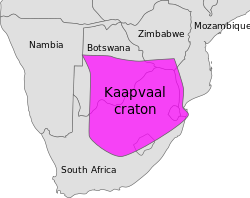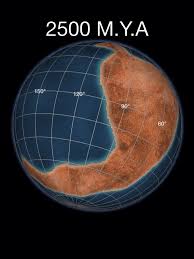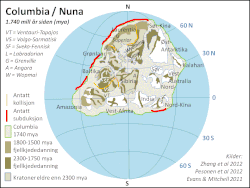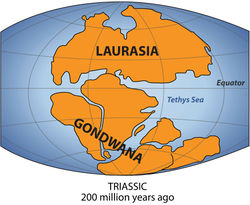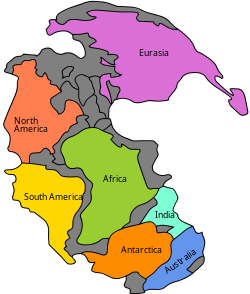Supercontinent
From eagle-rock.org
Higher topic: History
Underlying topic(s):
Underlying topic(s):
- In geology, a supercontinent is the assembly of most or all of the Earth's continental blocks or cratons[1] to form a single large landmass. The definition of a supercontinent can be ambiguous. Sometimes a clustering of nearly all continents is meant, sometimes a supercontinent is also seen as one of two big continents that existed simultaneously.
- Supercontinents have assembled and dispersed multiple times in the past.
- The causes of supercontinent assembly and dispersal are thought to be driven by processes in the mantle. Approximately 660 km into the mantle, a discontinuity occurs, affecting the surface crust through processes like plumes and "superplumes".[2]
First supercontinent Vaalbara 3.1 billion BP
- Vaalbara is Earth's theorized first supercontinent. There is some dispute as to Vaalbara's supremacy as the oldest supercontinent as the Australian continent also contains remnants of Ur. Vaalbara is understood to have been a complete supercontinent by 3.1 billion years ago. Vaalbara possibly formed beginning 3.6 billion years ago and was broken apart by about 2.8 billion years ago.
- Vaalbara is Earth's theorized first supercontinent. There is some dispute as to Vaalbara's supremacy as the oldest supercontinent as the Australian continent also contains remnants of Ur. Vaalbara is understood to have been a complete supercontinent by 3.1 billion years ago. Vaalbara possibly formed beginning 3.6 billion years ago and was broken apart by about 2.8 billion years ago.
Supercontinent Kenorland 2.7 billion BP
- Kenorland was one of the earliest supercontinents on Earth. Kenorland is thought to have formed during the Neoarchaean Era ~2.7 billion years ago (2.7 Ga). Kenorland comprised what later became Laurentia (the core of today's North America and Greenland), Baltica (today's Scandinavia and Baltic), Western Australia and Kalaharia. Kenorland also formed a substantial and substantive part of Nena, the supercontinent associated with the Sudbury Basin Impact.
- Kenorland was one of the earliest supercontinents on Earth. Kenorland is thought to have formed during the Neoarchaean Era ~2.7 billion years ago (2.7 Ga). Kenorland comprised what later became Laurentia (the core of today's North America and Greenland), Baltica (today's Scandinavia and Baltic), Western Australia and Kalaharia. Kenorland also formed a substantial and substantive part of Nena, the supercontinent associated with the Sudbury Basin Impact.
Supercontinent Columbia = Nuna 2.5-1.6 billion BP
Wikipedia: Columbia (supercontinent)
- Columbia, also known as Nuna and Hudsonland, was one of Earth's ancient supercontinents. It is thought to have existed approximately 2.5 to 1.6 billion years (Ga) ago. Columbia consisted of proto-cratons that made up the cores of the continents of Laurentia, Baltica, Ukrainian Shield, Amazonian Shield, Australia, and possibly Siberia, North China, and Kalaharia as well.
- Columbia, also known as Nuna and Hudsonland, was one of Earth's ancient supercontinents. It is thought to have existed approximately 2.5 to 1.6 billion years (Ga) ago. Columbia consisted of proto-cratons that made up the cores of the continents of Laurentia, Baltica, Ukrainian Shield, Amazonian Shield, Australia, and possibly Siberia, North China, and Kalaharia as well.
Supercontinent Rodinia 1.3-0.8 billion BP
File:Rodinia reconstruction.jpg
Proposed reconstruction of Rodinia for 750 million years ago
- Rodinia is a Neoproterozoic supercontinent that was assembled 1.3–0.9 billion years ago and broke up 750–600 million years ago.
- Rodinia is a Neoproterozoic supercontinent that was assembled 1.3–0.9 billion years ago and broke up 750–600 million years ago.
Mini supercontinent Euramerica c. 400 million BP
- Euramerica (also known as Laurussia (not to be confused with Laurasia), the Old Red Continent or the Old Red Sandstone Continent) was a minor supercontinent created in the Devonian as the result of a collision between the Laurentian, Baltica, and Avalonia cratons (Caledonian orogeny). 300 million years ago in the Late Carboniferous tropical rainforests lay over the equator of Euramerica. A major, abrupt change in vegetation occurred when the climate aridified. The forest fragmented and the lycopsids which dominated these wetlands thinned out, being replaced by opportunistic ferns. There was also a great loss of amphibian diversity and simultaneously the drier climate spurred the diversification of reptiles.
- Euramerica (also known as Laurussia (not to be confused with Laurasia), the Old Red Continent or the Old Red Sandstone Continent) was a minor supercontinent created in the Devonian as the result of a collision between the Laurentian, Baltica, and Avalonia cratons (Caledonian orogeny). 300 million years ago in the Late Carboniferous tropical rainforests lay over the equator of Euramerica. A major, abrupt change in vegetation occurred when the climate aridified. The forest fragmented and the lycopsids which dominated these wetlands thinned out, being replaced by opportunistic ferns. There was also a great loss of amphibian diversity and simultaneously the drier climate spurred the diversification of reptiles.
Supercontinent Gondwana 300-180 million BP
- Gondwana is the name given to the more southerly of two supercontinents (the other being Laurasia) that were part of the Pangaea supercontinent that existed from approximately 300 to 180 million years ago. Gondwana formed prior to Pangaea, then became part of Pangaea, and finally broke up after the breakup of Pangaea. Gondwana included most of the landmasses in today's Southern Hemisphere, including Antarctica, South America, Africa, Madagascar, and the Australian continent, as well as the Arabian Peninsula and the Indian Subcontinent, which have now moved entirely into the Northern Hemisphere.
- Gondwana is the name given to the more southerly of two supercontinents (the other being Laurasia) that were part of the Pangaea supercontinent that existed from approximately 300 to 180 million years ago. Gondwana formed prior to Pangaea, then became part of Pangaea, and finally broke up after the breakup of Pangaea. Gondwana included most of the landmasses in today's Southern Hemisphere, including Antarctica, South America, Africa, Madagascar, and the Australian continent, as well as the Arabian Peninsula and the Indian Subcontinent, which have now moved entirely into the Northern Hemisphere.
Supercontinent Laurasia 300-200 million BP
- Laurasia was the more northern of two supercontinents (the other being Gondwana) that formed part of the Pangaea supercontinent around 300 to 200 million years ago. Laurasia included most of the land masses which make up today's continents of the Northern Hemisphere, chiefly Laurentia, Baltica, Siberia, Kazakhstania, and the North China and East China cratons.
- Laurasia was the more northern of two supercontinents (the other being Gondwana) that formed part of the Pangaea supercontinent around 300 to 200 million years ago. Laurasia included most of the land masses which make up today's continents of the Northern Hemisphere, chiefly Laurentia, Baltica, Siberia, Kazakhstania, and the North China and East China cratons.
Supercontinent Pangaea 300-175 million BP
- Pangaea or Pangea was a supercontinent that existed during the late Paleozoic and early Mesozoic eras. It assembled from earlier continental units approximately 300 million years ago, and it began to break apart about 175 million years ago. In contrast to the present Earth and its distribution of continental mass, much of Pangaea was in the southern hemisphere and surrounded by a super ocean, Panthalassa. Pangaea was the last supercontinent to have existed and the first to be reconstructed by geologists.
- Pangaea or Pangea was a supercontinent that existed during the late Paleozoic and early Mesozoic eras. It assembled from earlier continental units approximately 300 million years ago, and it began to break apart about 175 million years ago. In contrast to the present Earth and its distribution of continental mass, much of Pangaea was in the southern hemisphere and surrounded by a super ocean, Panthalassa. Pangaea was the last supercontinent to have existed and the first to be reconstructed by geologists.
See also
References
.


